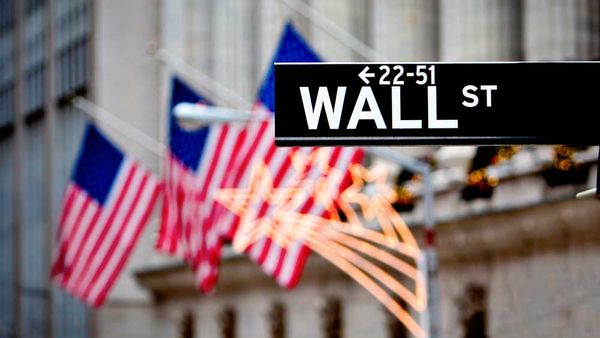Sellers came out in force and pounded stock indexes Thursday after President Donald Trump said new tariff rates on Chinese goods would climb higher than expected. A moderation in inflation didn't seem to help as the Dow Jones Industrial Average surrendered one third of Wednesday's massive gains on the stock market today.
Among the sectors making big moves, energy stocks were hit as the price of oil kept dropping. Also, semiconductor stocks fell in unison after chipmaking titan Taiwan Semiconductor reported a mild double-digit rise in monthly sales. Banking giants felt the pain as well ahead of some key earnings news, due early Friday.
At one point in Thursday's session, the Dow Jones Industrial Average drove more than 2,100 points lower, down more than 5%. But it shaved that drop to around 1,015 points by the close for a 2.5% loss. The Dow had soared nearly 3,000 points on Wednesday.
The S&P 500, still below its own 200-day line, managed to pare a loss of nearly 6% down to 3.5% by the close. The Russell 2000 sank 5%.
The Big Picture: Why Wednesday's Rocket Rebound Imitates The Action In March 2020
Meanwhile, the Nasdaq composite, a day after surging 12.2%, ended the day off 4.3% after notching a session low of 15,894.
And despite an early-afternoon rebound, the Nasdaq 100 still fell 4.2%. The decline underscored the fact that the 100 largest nonfinancial companies within the Nasdaq exchange were still not generating strong institutional demand. The Nasdaq 100's intraday high and low fall inside the high and low of Wednesday's wild up session.
3:49 p.m. ET
How These Nasdaq Sectors Performed
Only a small handful of industries among the 197 tracked each day by IBD squeezed out gains on Thursday. They included defensive issues such as nonalcoholic beverages, up 2.5% on a price-weighted basis; managed care firms, up 1.7%; wholesale drug supply, rising 1.2%; water utility stocks, flowing 1% higher; insurance brokers, gaining 0.9%; and meat, fattening 0.8%.
On a three-month basis, gold mining led the way with a 23% gain, followed by drugstore retailing, up 16.9%; managed care, gaining 12.8%; wholesale drug supply, climbing 12.1%, and tobacco and wireless telecom, both ahead 9.4%.
Hence, technically speaking this means the short-term direction of stock prices is extremely opaque. What is clear is that since March 24, Investor's Business Daily's current outlook remains extremely defensive with a suggested exposure of 0% to 20% for active trading.
Oil Price Drops Hit Energy Stocks
The energy patch got hit hard too. U.S. oil and gas explorer stocks have tanked as near-term expiring light sweet crude oil futures dove more than 3% and briefly hit a session low of $58.76 per barrel. Oil has sunk 16% after starting the new year at $71.72 a barrel.
Among the losers Thursday was EOG Resources. It led a broad sell-off, falling to its lowest level in more than two years. EOG, which posted a 12% drop in fourth-quarter sales to $5.59 billion as earnings shrank 11% to $2.74 a share, reports first-quarter results on May 1.
Also, Shell sank more than 6% and made an intraday low of 59.43 after recently crafting a bearish double-top formation. Shell had worked on a new base over the past seven months but failed to break out past the cup's left-side peak of 74.46.
2:13 p.m. ET
Taiwan Semiconductor Gives Back Some Gains
Shares of Taiwan Semiconductor, also known as TSMC, dropped amid an inside day compared with a wild 12.3% reversal higher on Wednesday. In an inside day on a daily chart, the day's high and low sit inside the respective high and low of the previous session.
Nonetheless, TSM stock has suffered a waterfall decline since it gapped down hard on Jan. 27 on news of China's new artificial intelligence-driven app, DeepSeek, requires a relatively lower amount of tech spending to handle a certain type of artificial intelligence tasks.
TSMC hosts a severely wounded 32 Relative Strength Rating on a scale of 1 to 99. This means the stock has outperformed less than a third of all companies in the IBD database over the past 12 months. According to MarketSurge data, the three-month RS Rating is even more sour at 20. At this point, watch for a new base to develop; TSMC is nowhere near a proper buy point.
TSMC posted a 10% rise in total net revenue vs. a year ago to $285.9 billion New Taiwan dollars. That comes out to roughly $8.72 billion. For the January to March quarter, sales have leaped 41.6% to $839.25 billion Taiwan dollars. However, the March increase hints at slowing growth.
Taiwan Semi stock has collapsed in recent weeks, falling more than 34% below its all-time peak of 226.40. Put another way, TSMC needs to rally 50% just to get back to that high.
1:23 p.m. ET
Stock Market Today: These Dow Stocks Pace The Downside
At least 10 members of the 30-stock Dow industrials caved six points or more, which is significant since the index is price-weighted, not market cap-weighted. Nike, Walt Disney and American Express helped pace the downside. UnitedHealth was one of the few in the black.
Walmart also defied the sell-off. The discount retailer is a Dow industrials leader with a 92 Relative Strength Rating. Walmart's earnings are expected to rise 4% in the current fiscal year ending in January 2026 to $2.61 a share, then accelerate 12% to $2.93 in fiscal 2027.
Driving the price action was Trump's clarification that tariffs on China would actually be 145% instead of his previous threat of a 125% levy. The news comes a day after Trump held off on imposing many tariffs on other countries for 90 days, sparking what turned out to be a rally of historic proportions.
Both the U.S. and China have threatened massive taxes on imports from each other's nation's products, a move that could have wide-ranging effects on a slew of sectors.
Stocks, Dollar Tumble On Tariff Fears; Inflation Data Due
Stock Market Today: Gold Miners Prevail
Gold miners, however, seemed immune to Thursday's market plunge. Among the leading members of IBD's gold and silver mining industry group, Agnico Eagle Mines aimed for a fourth-straight gain.
Agnico is the sole stock on the Leaderboard model stock portfolio of market leaders.
Within the MarketSurge Growth 250 list, nine of the top 10 risers hailed from the gold and silver, and metal ores industry groups. Royal Gold, a collector of royalties from operating gold mines, jumped more than 4% and notched a fresh high of 172.30.
Volume jumped 35% above average. The midcap stock recently retook a 154.18 entry point in a four-month double bottom and has gotten extended past the 5% buy zone.
The only non-gold stock up in the MarketSurge Growth 250: Alignment Healthcare. Shares have surged more than 57% past a double-bottom base 13.33 buy point. The provider of customized care programs for seniors boasts solid earnings and sales growth that have accelerated over the past three quarters.
JPMorgan Results Kick Off Earnings Season
But JPMorgan Chase, the largest U.S. bank by market cap at $636 billion, slumped back below its 200-day moving average. JPMorgan is in the early stages of possibly forming the right side of a double-bottom pattern. The company reports first-quarter results on Friday before the market open.
The daily chart of JPMorgan shows the stock falling well below the double bottom's first low of 224.23 marked on March 13. This is exactly the ideal action in an emerging double-bottom base. Investors should look for a big shakeout of weak holders as those shares fall into the hands of more committed players on Wall Street.
For now, the proper buy point for JPMorgan stands at 254.67, or the middle peak in between the first low of 224.23 and the second low of 202.16.
According to IBD Stock Checkup, the money center holds a solid 88 Earnings Per Share Rating, but the Accumulation/Distribution Rating of D- is weak. Watch for this rating to improve to at least C+ or higher before considering a timely buy.
Wall Street sell-side analysts see JPMorgan's earnings rising 4% to $4.63 a share on a 5% revenue increase to $44 billion.
10:35 a.m. ET
Inflation Subsides A Touch
Investors generally opted against bidding up stock prices even though U.S. consumer prices rose less than expected in March. The Consumer Price Index fell 0.1% vs. February, down from a 0.2% gain in the prior month, while rising 2.4% year over year. Econoday earlier forecast a 2.6% increase.
Core prices, excluding volatile food and energy products, also showed deceleration. The core index gained 2.8% vs. economists consensus estimate for 3% and was significantly down from 3.1% growth in February.
However, even a 2.8% rise in core consumer-level prices remains well above the Federal Reserve's long-range goal of 2% inflation.
Jim Baird, CIO of Plante Moran Financial Advisors, believes that the rate of inflation remains "at a crossroads" but adds that investor uncertainty remains high. Why so? "It's the near certainty that prices are heading higher in the near term to a degree that's difficult to engage," Baird wrote in comments sent to IBD. Plante Moran has $21.7 billion in assets under management as of Dec. 31.
Baird adds that amid the start of tariffs on imported goods, currently set at a minimum 10% for all exporters to America, consumers "are much more likely to trade down to cheaper alternatives or delay discretionary purchases" and this behavior change "raises the probability of a more notable slowdown in the pace of the economy."
Economists at BNP Paribas, meanwhile, noted that while the March CPI figures were driven in large part by "significant declines" in airfares and hotel fees, the lower than expected rise "reflects a U.S. inflation trajectory that was likely headed toward 2% year over year if not for recently announced tariffs." Andy Schneider, senior U.S. economist at BNP, also offered a preliminary March forecast for the core PCE (personal consumption expenditures) inflation index at 0.14% growth month on month.
The yield on the key U.S. 10-year government bond slid eight basis points to 4.31% after a hot three-day run as institutions and likely foreign governments dumped U.S. Treasury notes, sending yields shockingly higher on Monday through Wednesday.
When Will The Stock Market Bottom For Real? Look For This
Stock Market Today: Tech Firms Cool Off
Technology stocks also pulled back sharply.
The VanEck Semiconductor exchange traded fund, which pole-vaulted 17% on Wednesday, pulled back. The ETF's 50-day moving average has been sliding sharply in recent weeks, a sign that semiconductor shares have entered a downtrend. The IBD growth stock methodology opts against buying weak industries and sectors on the dip.
The trade war between the U.S. and China has not at all subsided, but U.S.-traded China-focused ETFs showed mild moves on the stock market today.
The iShares China Large Cap ETF edged downward after bolting 7% higher on Wednesday. Notice on a daily chart how the fund has found bullish support near its 200-day line. Still, the ETF forced recent buyers to cut losses on April 4 as it fell 7% below a breakout point of 37.49 in a six-month cup with handle.
The Krane CSI China Internet fund moved higher after a 6% rebound on Wednesday. However, at around 30 Krane CSI remains nearly 22% below a near-term high of 38.39.
Please follow Chung on X/Twitter: @saitochung and @IBD_DChung










